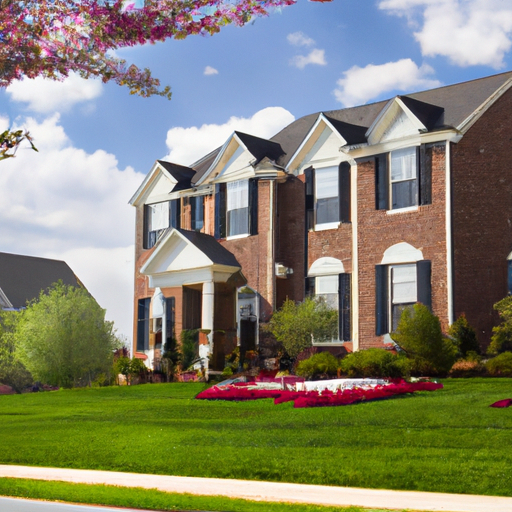Maryland offers a unique blend of history, natural beauty, and urban opportunities, making it an attractive place to call home. But before you rush into the exciting world of house hunting, it’s crucial to understand the average home price in this picturesque state. Whether you’re a prospective buyer or simply curious about the local real estate market, this article will provide you with a comprehensive overview of the average home price in Maryland. Embark on this journey with us and discover the average prices that currently define the housing landscape of the Old Line State.
1. Overview
1.1 Introduction to Maryland real estate market
If you’re considering buying or selling a home in Maryland, it’s important to understand the state’s real estate market. Maryland boasts a diverse housing market, with a wide range of home prices depending on factors such as location, size, condition, and amenities. This article will provide an overview of the Maryland real estate market, including factors influencing home prices, the current state of the market, average home prices in different regions of Maryland, price trends over time, factors affecting regional price variations, affordability challenges, and the outlook for Maryland’s real estate market.
1.2 Importance of understanding average home prices
Understanding the average home prices in Maryland is crucial for both home buyers and sellers. For buyers, knowing the average home prices within their desired region helps them determine their budget and what they can afford. It also allows them to compare different areas and make informed decisions. Sellers, on the other hand, can use the average home prices to price their property competitively and attract potential buyers. Additionally, understanding the average home prices can help individuals gauge the potential return on investment and make informed decisions when it comes to real estate transactions.
2. Factors influencing home prices
2.1 Location
Location plays a significant role in determining home prices in Maryland. Properties in desirable locations, such as those close to major cities, good school districts, and amenities, tend to have higher prices. In contrast, properties located in less desirable areas or areas with limited amenities may have lower prices. The proximity to employment opportunities, transportation infrastructure, and recreational facilities also affect home prices.
2.2 Property size and condition
The size and condition of a property are important factors influencing its price. Larger homes generally have higher price tags than smaller homes, reflecting the increased square footage and potential for more living space. Similarly, well-maintained properties in good condition typically command higher prices than those in need of renovations or repairs. The age of the property, the quality of construction, and any upgrades or renovations also impact its value.
2.3 Amenities and neighborhood
The amenities available in a neighborhood can significantly impact home prices. Communities with features like parks, shopping centers, restaurants, and recreational facilities tend to have higher property values. Additionally, neighborhoods with low crime rates and good school districts are often more desirable and therefore command higher prices. Factors like walkability, access to public transportation, and the overall quality of the neighborhood also influence home prices.
2.4 Economic factors
Economic conditions have a direct impact on the real estate market, including home prices. Factors such as job growth, income levels, and overall economic stability can affect the demand for housing and, subsequently, its price. In times of economic growth and prosperity, the demand for homes tends to increase, driving up prices. Conversely, during economic downturns or recessions, home prices may decline as demand decreases.
2.5 Interest rates
Interest rates play a crucial role in the affordability of homes. When interest rates are low, it becomes more affordable for individuals to borrow money and finance their home purchases. This increased affordability can lead to higher demand for homes and subsequently drive up prices. On the other hand, when interest rates are high, borrowing becomes more expensive, which may deter some potential buyers and lead to lower demand and lower home prices.

3. Current state of Maryland’s real estate market
3.1 Trends in home prices
Maryland’s real estate market has experienced notable trends in home prices in recent years. The state has witnessed overall appreciation in home values, with prices steadily increasing. However, the rate of growth and price appreciation varies across different regions within Maryland. Some areas have seen more substantial increases in home prices, while others have experienced more moderate growth. Understanding these trends is essential for buyers and sellers to make informed decisions and strategize their real estate transactions.
3.2 Supply and demand dynamics
The supply and demand dynamics in Maryland’s real estate market also influence home prices. When there is a high demand for homes and a limited supply, prices tend to rise. Conversely, when there is an oversupply of homes and a lower demand, prices may stabilize or even decrease. Factors such as population growth, housing inventory levels, and the pace of new construction projects all affect the supply and demand dynamics in the market and, subsequently, home prices.
4. Average home prices in different regions of Maryland
4.1 Overview of Maryland’s regions
Maryland is divided into different regions, each with its unique characteristics and housing market. Understanding the average home prices in these regions provides valuable insights for individuals considering buying or selling a property. Some of the key regions in Maryland include Baltimore, Montgomery County, Prince George’s County, Anne Arundel County, Howard County, Frederick County, Baltimore County, Harford County, and several others.
4.2 Average home prices in Baltimore
Baltimore, the largest city in Maryland, offers a range of housing options at varying price points. The average home price in Baltimore fluctuates depending on the neighborhood, property size, and condition. As of the latest data available, the average home price in Baltimore is approximately $200,000.
4.3 Average home prices in Montgomery County
Montgomery County, located in the suburbs of Washington, D.C., is known for its highly desirable communities and excellent school districts. Home prices in Montgomery County tend to be higher compared to other regions in Maryland. The average home price in Montgomery County is currently around $500,000.
4.4 Average home prices in Prince George’s County
Prince George’s County, also situated in the suburbs of Washington, D.C., offers a more affordable housing market compared to Montgomery County. The average home price in Prince George’s County is approximately $300,000, making it an attractive option for those seeking relatively lower-priced homes in proximity to the nation’s capital.
4.5 Average home prices in Anne Arundel County
Anne Arundel County, located in close proximity to Baltimore and Annapolis, offers a mix of suburban and coastal living. The average home price in Anne Arundel County is around $400,000, reflecting the desirable location and quality of life it offers to residents.
4.6 Average home prices in Howard County
Howard County, often recognized for its exceptional schools and high standard of living, has higher average home prices compared to many other regions in Maryland. The average home price in Howard County currently stands at approximately $600,000.
4.7 Average home prices in Frederick County
Frederick County, situated northwest of Baltimore, is known for its historic charm and scenic landscapes. The average home price in Frederick County is around $350,000, offering relatively more affordable housing options compared to some neighboring counties.
4.8 Average home prices in Baltimore County
Baltimore County, surrounding the city of Baltimore, consists of diverse neighborhoods and housing options. The average home price in Baltimore County is approximately $300,000, making it an attractive choice for those seeking proximity to the city at a relatively lower price point.
4.9 Average home prices in Harford County
Harford County, located northeast of Baltimore, offers a mix of suburban and rural living. The average home price in Harford County is around $300,000, providing affordable housing options for individuals and families.
4.10 Average home prices in other regions
Maryland’s real estate market extends beyond the regions mentioned above, with each offering its unique housing market and average home prices. Other regions in Maryland include Carroll County, St. Mary’s County, Charles County, Allegany County, and many more. It is essential to research and consult local real estate professionals to gain insights into the average home prices and characteristics of these regions.

5. Price trends in Maryland over time
5.1 Historical price data
Analyzing historical price data can provide valuable insights into price trends in Maryland’s real estate market. Over the years, Maryland has seen overall appreciation in home values, with prices generally trending upward. However, it is crucial to note that price trends can vary across regions and even within different neighborhoods. It is advisable to consult local market reports or work with a real estate agent familiar with the area to gain a deeper understanding of the specific price trends.
5.2 Impact of housing market cycles
Maryland’s real estate market, like any other market, is influenced by housing market cycles. These cycles typically include periods of growth, stability, decline, and recovery. Understanding how these cycles affect home prices is essential for making informed decisions. During periods of growth, home prices tend to increase, while during periods of decline, home prices may decrease or stabilize. Identifying the current phase of the housing market cycle can assist buyers and sellers in their decision-making processes.
6. Factors that affect regional price variations
6.1 Economic factors
Economic factors significantly impact regional price variations in Maryland’s real estate market. Areas with strong job growth, diverse industries, and high-income levels often experience higher home prices compared to regions with limited economic opportunities. Additionally, factors such as proximity to major cities and transportation infrastructure can influence the desirability and subsequent home prices of an area.
6.2 Housing inventory
The availability of housing inventory also affects regional price variations. Regions with a limited supply of homes compared to high demand usually experience higher home prices due to increased competition among buyers. Conversely, areas with a surplus of homes on the market might see price reductions to attract buyers.
6.3 Development projects
The presence of development projects, both commercial and residential, can impact regional price variations. Areas experiencing significant commercial development or infrastructure improvements may see an increase in demand for housing, subsequently driving up prices. Similarly, the introduction of new residential projects, especially in highly sought-after neighborhoods, can influence price variations in the region.

7. Affordability challenges in Maryland
7.1 Median household income
Affordability challenges in Maryland’s real estate market relate closely to the median household income. While Maryland boasts a higher median income compared to the national average, the cost of living and higher home prices can still pose challenges for many residents. Affordability varies across regions within Maryland, with some areas having higher incomes that align better with the higher cost of housing.
7.2 Affordability index
The affordability index is an important tool for analyzing the relationship between home prices and income levels. The index compares median household income to the average home price, indicating the affordability of housing in a specific area. A lower affordability index implies that housing may be less affordable for the average resident, while a higher affordability index suggests greater affordability.
7.3 Programs and initiatives for affordable housing
To address affordability challenges, Maryland offers various programs and initiatives for affordable housing. These programs aim to assist low-income households, first-time homebuyers, and individuals with special needs in accessing affordable housing options. Examples include down payment assistance programs, affordable rental housing programs, and tax credits for affordable housing developers. These initiatives contribute to promoting the availability of affordable housing options within the state.
8. Outlook for Maryland’s real estate market
8.1 Forecast for home prices
The outlook for Maryland’s real estate market is subject to various factors, including economic conditions, population growth, and housing market trends. While it is challenging to predict home prices with certainty, experts anticipate continued growth in the market, albeit at varying rates across different regions. Factors such as supply and demand dynamics, interest rates, and economic indicators will contribute to shaping the future trajectory of home prices.
8.2 Impact of external factors
Maryland’s real estate market can be influenced by external factors such as changes in federal policies, economic fluctuations, and global events. For example, changes in mortgage lending regulations or tax laws can impact home buyers’ purchasing power and subsequently affect home prices. Additionally, economic downturns or global events can create uncertainties that influence buyer sentiments and real estate market dynamics.
8.3 Future trends and opportunities
Future trends in Maryland’s real estate market may include sustainable and energy-efficient housing, increased focus on urban revitalization projects, and the development of mixed-use communities. Additionally, advancements in technology, such as virtual reality tours and online platforms, may streamline the real estate transaction process and enhance the overall homebuying experience. Exploring these trends and opportunities can help buyers and sellers stay ahead in the ever-evolving real estate market.

9. Conclusion
Understanding the average home prices in Maryland and the factors influencing them is essential for anyone interested in the state’s real estate market. Factors such as location, property size and condition, amenities, economic conditions, and interest rates all contribute to the overall home prices. By analyzing current trends, regional price variations, affordability challenges, and the outlook for Maryland’s real estate market, individuals can make informed decisions when buying or selling a home. Consulting with local real estate professionals, conducting thorough research, and staying updated on market trends will prove valuable in navigating Maryland’s diverse and dynamic real estate market.

